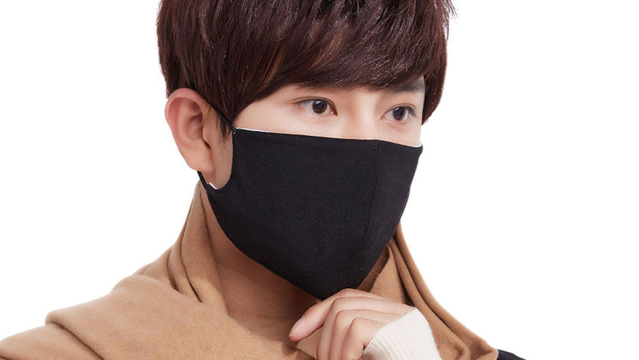It might be hot as hell in Australia, but for Japan it’s cold and flu season. That means people in Japan are wearing sickness masks in public. Either they are sick or are trying to avoid a cold.
The default is still the white sickness mask, but recently, black ones are becoming more popular among the country’s youth.
This recent trend in Japan appears to be K-pop powered.
黒いマスクを見つけてつい買ってしまいました!カッコイイ…(`・^・´) pic.twitter.com/vfgIlhSioQ
— ✳蒼井✳ (@aoi__0718__) February 4, 2019
During the past few years, when K-pop idols like boy band Shinee arrived in Japan, the popstars wore black sickness masks at the airport. (It’s unclear if Michael Jackson, who frequently travelled while wearing black sickness masks, was an inspiration.)
Black masks became popular because they could be a fashion accessory. White masks looked like something for patients or hospital staff. Other reasons for black masks’ popularity include that they make your face look smaller (a desirable trait in Japan and South Korea) than white ones do.
Another reason is that some masks have charcoal filters and claim to better protect against airborne illnesses. Then there is the way black masks can suit certain outfits.
黒マスクについてやってる pic.twitter.com/5XMSQMbbyE
— ハム太郎???? (@bts20010522) January 29, 2019
The dark masks first started to catch on with K-pop fans in Japan as well as visual-kei types around 2014 and 2015.
【ゴシック・黒マスク大HIT中!】
ファッションアイテムとしても注目度上昇中の黒マスク!
発売と 同時に大大大HIT中☆乗り遅れないようにチェックです><https://t.co/qvyULDHIo5 pic.twitter.com/jcEbXA8Ekh— Deorart(ディオラート)【公式】 (@Deorart_shop) January 25, 2016
The promotional campaigns targeted visual-kei and goth types.
新宿アンチノックお疲れ様でした
今年初ライブでしたね、遅い時間に出番でしたが、皆様観に来てくだすってありがたき幸せ。
次は1/30渋谷サイクロンにて20:35〜21:05です。よろしくお願いします
今日は怪しい黒マスク軍団でした。
黒マスク pic.twitter.com/v4jjUIzNi9— もっくん (@mokuniuka) January 24, 2019
Some Japanese pop stars, like Tsuyoshi from Kinki Kids, also started wearing black masks, much to the delight of fans. Members of the Japanese boy band Kis-My-Ft2 also ditched their plain old white masks for the sleeker black ones.
わたし黒マスクしてる人って基本苦手なのだけど剛さんの黒マスクって最高すぎる…!
なんでこうも似合ってしまうのか…!
剛さんって可愛いゆるいふわ〜な感じが多い中、たまに出す雄感の雄の部分が黒マスクによってより一層際立つからなのか…もう何言ってるかわからない#KinKiKids pic.twitter.com/04SkWrARMx— 堂本♡ひかり (@ki3kd51244) January 13, 2017
Now, black masks are slowly starting to reach a wider audience. Within the past few months, Japanese TV programs have introduced the trend. Josei Seven, one of Japan’s most popular and longest-running women’s magazine, recently did an article on the “black mask boom,” drawing a direct line to K-pop fashion.
しゃおるの皆様!!女性セブン最新号を是非ご覧くだしゃいに〜????
小さい写真だけど、ウリテミンちゃん????が黒マスクブーム?の記事で紹介されてますよーーー???? #SHINee #テミン #태민 #女性セブン pic.twitter.com/FZnl2Yobk6— あんどりゅー (@bunchintaem_) January 26, 2019
During the past few decades, black sickness masks have been seen as unseemly. In Japan, the stereotype was the bikers and hoodlums wore black masks to cover their faces while raising hell. These masks weren’t for illnesses, but rabble-rousing.
うむ、なんだか黒いマスク?が、流行りらしいが、白以外のマスクは、、
ヤンキー、不良なイメージ
それしかない pic.twitter.com/UOZ1Reiagm— 横田守 mamoru yokota (@yokotamamoru) January 14, 2019
This could be why that until K-pop stars started wearing black masks, people in Japan mostly stuck to white masks. Korean pop stars helped soften the image black masks had in Japan.
黒マスク集団
(怖くないよ、優しいよ) pic.twitter.com/mjwANVH2d4— 竹内彩姫☺︎ (@saki_t48) January 30, 2019
Now, these masks for fashionable Japanese youth, who are now wearing black masks to coordinate their outfits.
黒ますく♥
黒マスク持ってるはいいけど全然使わない。。 pic.twitter.com/JU1BfVQvDd
— 早川渚紗 (@nagisa_hayakawa) January 30, 2019
While the black mask boom might be a relatively recent, originally, masks in Japan were black.
黒マスクをしてる人が最近少しずつ増えていて、K-Popの影響とかヤンキーに見えるとか色々言われてるけど、元々日本で普及したマスクは黒マスクだったらしい。 pic.twitter.com/gKEdHosUvy
— 岩ノ城 (@JojiSensei) January 26, 2019
For example, here is a pre-World War II “Banzai” branded black mask. This is not the oldest one.
なんかどっかの国の影響で黒いマスクが認知されだしてるけど、衛生的な感じが微塵もしないんでどうかとは思う。けど、昔のバンザイマスクみたいなのが流行り出したら着けるかもしれないw pic.twitter.com/5gHiCT4tlV
— psy (@psytou) January 29, 2019
In 1879, a black mask was released in Japan and its packaging featured the curious English language brand name “Respiraltll.”
黒いマスク、見慣れないうちは不穏に感じていたけど、もう慣れた。明治から黒マスクはあったのね、へー。 pic.twitter.com/IVOrr5jpRD
— 鈴木祐介 (@7_color_world) February 4, 2019
Black masks might not be new to Japan, but thanks to the influence of Korean pop culture, they have definitely become more visible in youth areas like Tokyo’s Shibuya and Osaka’s Amemura as well as in online illustrations.
アイコン変えました!????
黒マスクってカッコイイけどつける自身はないな、????????
フリーアイコン使わせていただきます!
#新しいプロフィール画像 pic.twitter.com/edDM7M3p2G
— ✄しうまる❄まふらー????新年会余韻 (@uni_shiumaru) January 27, 2019
1番最初気に入ってる
黒マスク良いよね✨#画像メーカー pic.twitter.com/BUj0DzPs8P— 梨寿 (@rijyu_12) February 3, 2019
なんちゃらメーカー()で作ったゆきくん????????
おいぬさん抱っこVer.(個人的な好みで髪縛って黒マスク付けさせていただきました( ˊᵕˋ )♡)← pic.twitter.com/CWQZEqDY4c
— ????????????優咲姫(うさぎ)???????????? (@usagi_juwe) January 27, 2019
ダンテくんは学校に黒いマスクして先生に怒られて欲しい(でも気にしない) pic.twitter.com/ORjSMGKv0f
— まやん@無言フォロにてお迎え中です (@myn_oekk) January 9, 2019
ワンドロお題(金髪・黒マスク・ピアス)お借りして…( ˊᵕˋ ) pic.twitter.com/XKqDNoe56c
— 花科ユウ@超低浮上 (@hnk_ttt) July 6, 2018
黒マスク pic.twitter.com/5SK80gG7KZ
— イサム@いがなか5巻11/1発売 (@ISUMI_136) March 27, 2018
黒マスクうめめ
#白坂小梅 pic.twitter.com/0ENuZxDHQp— えりぃ (@elly__142) December 25, 2018
とたんにアクセごてごての黒マスク不良男子が描きたくなって????️ pic.twitter.com/cfMz4xZzpf
— 十鳥 (@Totori_Toiro) December 21, 2018

Comments
6 responses to “How K-Pop Revived Black Sickness Masks In Japan”
Gucci or whatever other pretentious fashion labels will be jumping in on this soon with designer masks embroided with swarovski crystals and gold lace.
already have 😐
https://scontent-syd2-1.xx.fbcdn.net/v/t1.0-9/51533352_10157421248122448_5829545491519504384_o.jpg?_nc_cat=102&_nc_ht=scontent-syd2-1.xx&oh=0a8187f29ea8bc7b6c2db9c8c26777b4&oe=5CE74EB6
These masks are all over kdramas these days, too.
huh I’ve been wearing black masks for several years. I didn’t know I was causing a fashion scene when going to Japan to visit relatives
oh well I guess every Asian country is different
You rebel you 😛
lol if this article is anything to go by then I imagine that’s how I’ve been perceived. although Japanese people are ridiculously polite so they would never actually show it.
meanwhile nobody bats an eyelid when I’m in South Korea, Hong Kong or Taiwan =p